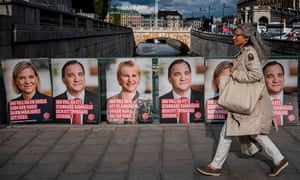Like all elections, Sweden’s has produced a lot of numbers. One number has received more attention than all the rest: 17.6, the percentage of the vote that went to the rightwing, anti-immigrant, nationalist Sweden Democrats – their highest ever score, and enough to make forming a new government a very complicated job for the mainstream parties.
A few other numbers, however, deserve a closer look. The populists advanced by 4.7 percentage points, a strong performance by any standard but very far from the 12-point leap, to around 25%, that they themselves and many pollsters had predicted.
Meanwhile, three other parties – the ex-communist Left, the Centre party and the centre-right Christian Democrats – put on a total of 6.5 points. And the big established parties of the centre-left and centre-right, the Social Democrats and the Moderates, lost 6.3 points between them.
The real story of Sweden’s election is not, as the prevailing narrative has it, the irresistible onward march of Europe’s far right but the continuing decline of the major parties of government, the fragmentation of national votes and the rise of a number of smaller parties.
In a trend visible across Europe, the electoral base of the leading mainstream parties is shrinking. “The bigger parties are getting smaller and the smaller parties getting bigger,” said Sarah de Lange, a political scientist at the University of Amsterdam and a specialist in Europe’s radical right.
Across the continent, mainstream parties and alliances that once dominated national politics are in retreat, most notably on the left, making coalition-forming harder – even in countries, like Sweden, long used to coalition government – and producing weaker, potentially shorter-lived governments.
Sweden’s latest results in some respects even showed parallels with the Netherlands, De Lange said on Twitter. There, fragmentation has become extreme: since the 1980s the combined score of the three main Dutch centre-right and centre-left parties of government has halved, from 80% to 40%, and no fewer than 28 parties contested the last election, 13 of them winning seats.
Simon Hix, a professor of European and comparative politics at the London School of Economics, said: “For me, the biggest take-home from the Swedish election is not the further rise of populists but the stunning volatility and party system fragmentation: it’s the Dutchification of European politics.”
Across western Europe, from Germany to France and Italy to Austria, parties that have dominated their national political stages since the end of the second world war have lost votes or lost outright in recent elections, not just to nation-first populists, but to liberal, Green and anti-austerity parties, and even new centrist movements.
Sweden, it seems, for all its historic two-bloc system and apparently cast-iron political stability, is no exception. “The bottom line is that Sweden is another European country: a fractured political landscape with the extremes doing better, including a populist party to the right,” said Carl Bildt, the conservative former Swedish prime minister.
Alexander Stubb, a former Finnish prime minister, made the same point: “Sweden’s election result follows the pattern in western democracies,” he said. “An unclear result, complicated coalitions and the decline of mainstream parties.”
Sweden’s results also reveal another Europe-wide trend: increasing voter volatility. According to one post-election survey by the Swedish public broadcaster SVT, a remarkable 41% of Swedish voters said they had cast their ballot for a different party this time than in 2014.
Smaller and non-mainstream parties are poaching votes from the big parties on both sides of the left-right divide. Data shows the Sweden Democrats, for example, gained support in almost exactly equal measure from the centre-left Social Democrats and the centre-right Moderates.
Niklas Bolin, of Mid Sweden University, said Sweden’s system was still showing some resistance. “The Social Democrats achieved a terrible score by their historic standards,” he said, “but they still managed more than 28%” – far more than the main centre-left parties of, for example, the Netherlands or France.
But overall the picture is consistent. Does this matter? Yes, say analysts, because the flimsy coalitions and splintered legislatures that often emerge from fragmented systems make it harder to govern. “They require coalitions involving more parties, and parties with a wide range of stances,” said De Lange.
And that can make it harder for countries to adopt reforms, pursue controversial policies – such as welcoming refugees, a major factor for many voters in Sweden’s election – or play a decisive role on the international stage.

I think the middle class is beginning to wake up slowly.